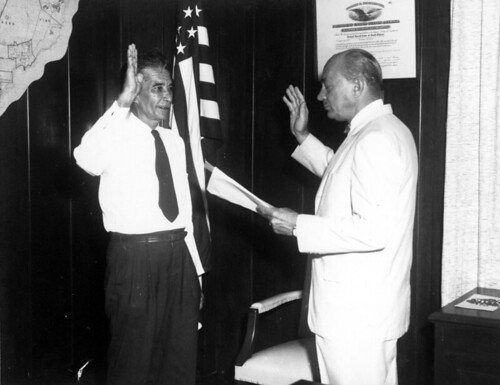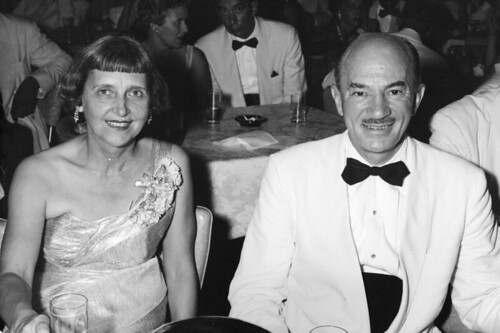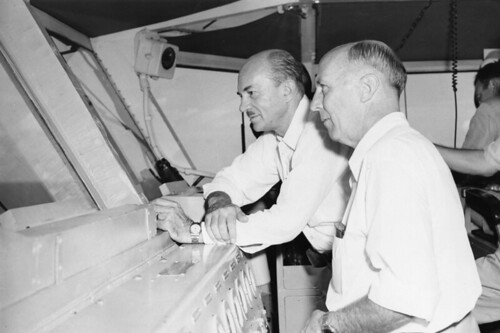Governor of Guam 1956-1959
Richard Barrett Lowe (1902 – 1972) was the third civilian governor of Guam. He was appointed by President Dwight D. Eisenhower and served on Guam from 1956 to 1959. Prior to his role as governor of Guam, he had been appointed territorial governor of American Samoa from 1953 to 1956.
Early life
The youngest of three children, Richard “Barrett” or “Barry” Lowe was born in Madison, Lake County, South Dakota, on 8 July 1902 to Edna Beck Lowe and Dr. William Lowe, the first medical doctor in Lake County. Lowe’s mother died a year later and he and his siblings were raised by his grandparents, Mr. and Mrs. George Beck.
Lowe had a long and varied career. He worked as a teacher in a one-room rural school in Manchester, South Dakota, in the early 1920s. He then left teaching to take over the operation of his grandfather’s furniture business. By 1926, Lowe had married his wife Emma Louise (“Emmy Lou”) and they had one son named Bruce.
He returned to teaching and went back to school, attending the University of Wisconsin, Defiance College and George Peabody College for Teachers before finally graduating in 1929 from Eastern State Teachers College (also known as Dakota State Normal School, now South Dakota State University). Later, he earned a Master’s degree from the University of South Dakota. During his senior year at the Normal School, Lowe wrote and directed the film Dacotah: Heroes and Hero Tales of South Dakota Twenty-Million Acres, which chronicled the history of South Dakota from prehistory to modern times. Produced entirely by students with a cast of over 300, Dacotah is believed to be the first full-length motion picture filmed entirely on an American college campus.
In addition to teaching, Lowe served as Superintendent of Schools at various locations in South Dakota, including Alcester, Wessington Springs and Yankton in the 1930s. He then became president of Sioux Falls College when the United States entered World War II in December 1941. Lowe was awarded an honorary Doctor of Education from Ottawa University in 1942 and later served as President of the South Dakota Education Association. He resigned this position in 1943 and went on active duty as a Navy Lieutenant.
During World War II, Lowe was a commander in the US Navy’s V-12 Officer Training Program at the University of Nebraska and Creighton University (also in Nebraska). By the end of the war, Lowe was attached to the Military Government Unit in Tinian. He first visited Guam in the fall of 1945 while on assignment. Because of his background in education, he was offered the directorship of education as well as a spot promotion if he would agree to stay in the Marianas for six months. However, Lowe declined the position and returned home.
After his stint with the Navy, Lowe was elected dean of Nebraska State Teachers College (now Peru State College) in February 1946. He reconsidered taking the position in Guam shortly after becoming dean the directorship was already filled. In 1947, he assisted with a recruiting drive for the US Navy Reserves, convincing top officials to emphasize the importance of education and to adopt the slogan, “Stay in School.”
Through the late 1940s and early 1950s Lowe was very active attending national educational conventions and participating in various panel discussions as a member of the armed forces. He was invited to serve as a consultant to the Canadian Recruiting Service and was promoted to Commander. Although he was recommended to head a unified office in the Pentagon, the position never materialized, but he did gain support from the Navy and leading educators to be appointed a governorship.
Governor of American Samoa
In 1953, President Eisenhower appointed him as Governor of American Samoa, a US territory in the South Pacific about 2,600 miles southwest of Honolulu, Hawai’i. According to former Congressman and House Interior and Insular Affairs chair Wayne N. Aspinall, Lowe had several noteworthy achievements. As governor, Lowe had promised his administration would “relinquish appropriate authority to capable Samoans as rapidly as they were ready to assume responsibilities.”
During his administration, he stylized and stabilized the executive structure of the territorial government. In early 1954 Lowe issued an executive order to establish a Constitutional Committee to explore the possibility of creating organic legislation for the people of Samoa to maintain their system of land tenure and social organization. This committee also took the first steps to draft what eventually became the Constitution of American Samoa.
Also, while governor, Lowe helped promote the tuna canning industry, which eventually became the territory’s largest private industry. Lowe served in American Samoa until 1956 when Eisenhower appointed him governor of Guam. From October 2-15, 1953, he was simultaneously the governor of both American territories.
Governor of Guam
On Guam, Lowe was only the third civilian appointed governor of the island, following Carlton Skinner and Ford Elvidge, after fifty years of naval rule. When Elvidge resigned, the executive branch was temporarily placed in the inexperienced hands of acting governor Ted Corbett. Lowe was a better candidate to replace Elvidge, however, because of his work in American Samoa. As governor of Guam, Lowe would receive $6,000 more than he received in American Samoa, as well as “free housing, automobile and driver, domestic staff and an adequate expense account for travel and entertainment.”
In fact, the Guam governorship was one of the best paying jobs in the federal government at the time and Lowe considered this an advance to his position in American Samoa. However, Lowe hesitated in taking the position partly for political reasons. The year 1956 was an election year, and if President Eisenhower, who was running for another term in office in spite of a recent heart attack, had been defeated, Lowe would only be an interim appointment with no back pay while he waited for Senate confirmation. Lowe also felt he had unfinished work in American Samoa and had developed a deep affection for the people there. Eisenhower and Department of Interior Secretary Fred Seaton, however, assured Lowe that he could be appointed immediately in Guam and that Peter Tali Coleman, Lowe’s attorney general and a half Samoan born and raised in Samoa, would be his successor there. With much heartfelt emotion, Lowe and his wife Emmy Lou left for their new assignment on Guam.
Lowe was sworn in as Governor of Guam on 14 October 1956 in Washington, DC, and was inaugurated into office on 31 October in Guam. In his inaugural address before an estimated crowd of 800 people at the Plaza de España, he declared:
I believe in Guam for the Guamanians…[but should there] be a conflict of local interest you, as loyal Americans, will agree with me…that the best interests of the United States are your best interests, too. You amply demonstrated this by your loyalty during the difficult years of World War II, which was a source of pride to the United States…I believe in the dignity of the individual, and that the government of the people should be an open government, and I bring to you an open mind, an open heart and sincerity of purpose. I assure you that I am not going to take precipitous action of any kind regarding any problem until I have had an opportunity to learn the facts. I shall strive to take the long view in making day to day decisions, and will do my best to be impartial.
Speaker of the Legislature FB Leon Guerrero extended the territory’s official welcome to Lowe and his wife, presenting them with a resolution expressing the best wishes of the people of Guam.
The new governor had to contend first with the bad publicity stemming from former governor Elvidge’s harsh criticism of Guam in the Saturday Evening Post as “Uncle Sam’s problem child.” Lowe countered by asserting that “no governor rules people,” and that Guam was no more a “problem” than any of the other territories. Still, Lowe conceded that the description Elvidge gave in the article reflected, “in many ways the problems a governor faces in ‘paradise.’” In his memoirs, Lowe described his term in office:
I started out with good public relations and continued to enjoy that status throughout my term. This does not mean that everything I did or said was agreed with, but I was always treated fairly by the press and radio, without challenge to my integrity or motives.
While in office, Lowe continued the process of converting the military government to one run by civilians. According to historians Paul Carano and Pedro Sanchez, Lowe’s first tasks as governor included reorganizing the executive department, including the creation of a new position of Assistant Secretary of Guam. Lowe appointed Manuel Guerrero, a deputy director of Land Management and prominent member of the Popular Party for the position of Assistant Secretary. Guerrero served as an adviser to the governor, and as a liaison with the legislature. Indeed, Lowe’s term saw the appointment of Chamorros to other important government positions. Lowe wrote:
Right or wrong, I think I did the proper thing in encouraging the appointment of local men to such positions, although my activities in this respect did not endear me to large numbers of native residents both in American Samoa and in Guam.
Lowe initiated numerous capital improvement projects, including the construction of a new and permanent administration building, the Territorial College of Guam (now the University of Guam), several public elementary and secondary schools and municipal buildings in the different villages. While Lowe was in office, the island’s radio station, KUAM, began broadcasting television programming; commercial development began to spread along Marine Corps Drive in Tamuning; and the newly constructed Guam Memorial Hospital in Oka was dedicated.
It so happened that in 1956 when Lowe took office, it was also an election year for the Guam legislature and a majority of the newly elected members were untrained or inexperienced for their positions. Unlike his predecessor Governor Elvidge, Lowe worked more cooperatively with the legislature, and he was determined to remain aloof from local politics. He and Assistant Secretary Manuel Guerrero organized a series of executive-legislative conferences to assist the newly elected congressmen and find common ground. However, there were several issues that brought opposition and challenge to Lowe’s administration – the question of income taxes, the control of public utilities, and the laws surrounding immigration into Guam.
For the years since the Organic Act was put into effect, the legality of income taxes collected by the Government of Guam (“GovGuam”) under Section 31 was the subject of debate between Lowe and some members of the business community. These businessmen contended that the collection of income taxes by GovGuam was illegal because it violated federal income tax laws that should be applicable to Guam. Lowe, however, pushed the US Congress to clarify its intent with Section 31, declaring that income tax collected on Guam was a territorial tax. Lowe’s effort to solidify the authority of the Government of Guam to collect income taxes was one of his greatest contributions.
Another issue that arose in Lowe’s term was the maintenance of public utilities. Although the government controlled the utilities, there was talk, especially in the legislature, of turning over control of public utility functions to private enterprises. Lowe, however, was adamant that GovGuam maintain control, fearing that such a move would “turn over to private individuals over seven million dollars’ worth of government property without any guarantee of repayment.”
When Lowe’s term was almost over another major issue arose regarding immigration. The US Department of Immigration had issued a ruling that would limit the employment of all Filipino contract laborers working for the civilian community to a three-year period. In addition, the ruling restricted the import of any additional laborers from the Philippines. Lowe objected, believing “it would undermine the economic development of the territory.” Working with the legislature and the Guam Chamber of Commerce, Lowe was able to get the ruling modified, proposing a seven-year “phase-out” program and forcing the federal government to send someone to Guam to consult with the local government and other interested parties. His efforts were well-received by the Filipino community on Guam, and also helped improve US relations with the Philippine government at the time.
Lowe’s administration ushered in the beginning of federal aid for Guam in critical areas of education, public health, vocational rehabilitation and library and medical services. Lowe was able to secure a full-time auditor general to audit government accounts and conducted an economic and personnel survey for the government. In spite of pressure from the legislature and the business community, Lowe continued to assert control as governor and define the powers of the executive branch.
Although Lowe maintained a cordial relationship with the Navy through most of his term, in 1959 his relationship with Rear Admiral W. L. Erdmann of the Naval Marianas Command was frustrating. According to historian Robert Rogers, unlike his predecessor, Admiral William Ammon, Erdmann “attempted to reassert naval authority over the civilian government. He criticized GovGuam officials, requested a special school for military dependents, snubbed Governor Lowe, and prohibited navy personnel from attending some local public events.” Their contentious relationship made headlines on Guam and in Honolulu, although the Governor apparently managed to keep a low profile from the publicity and avoided reprimand from the Department of Interior. Lowe requested that Erdmann be recalled, but he was refused.
Governor Lowe resigned a month before his term was over in November 1959. Before he resigned, however, he recommended that Joseph Flores, businessman and publisher-editor of the Guam Daily News replace him. In his memoirs, Lowe maintained that Flores’ appointment was delayed by Secretary Seaton at the Department of Interior and was contingent upon Flores’ agreement to resign the governorship position if a Democrat president was elected. Flores, the first appointed Chamorro governor, was sworn into office in June 1960. (True to his word, Flores resigned less than a year later when John F. Kennedy was elected.) In addition, there were local challenges to Flores’ appointment, especially by influential business leaders (mostly statesiders) who were concerned Flores would pursue his own business interests, but also those detractors who did not want a native governor.
Upon his resignation, Lowe had been offered a position within the Interior, but instead moved to Alexandria, Virginia, where he switched careers and began restoring historic houses. One of his big projects was the restoration of the George Washington Townhouse. Originally built in 1769, the structure was demolished in 1855. Lowe, however, restored the townhouse in 1960 using bricks and stone excavated from the original structure.
Lowe was the first American governor to write a book about his administration. Entitled, Problems in Paradise: The View from Government House, the book, published in 1967, detailed his experiences as governor of Guam and American Samoa. In his memoirs, Lowe declared that the main reason he resigned the governorship of Guam was “to enable the national administration to advance the cause of self government there, as had been done in American Samoa and the Virgin Islands, by the appointment of a local resident as governor.” Furthermore, Lowe “agreed with Secretary Seaton that this would be a desirable step to take, because I [Lowe] considered it to be an improvement in government, pending the time when the territory would be allowed to elect its own governor.”
Lowe wrote of his support for an elected governor and delegate for Guam, stating, “I firmly believe that Guam and the Virgin Islands should be allowed to elect both their delegates to Congress and their own governors. I think that provisions for these two elective offices should be made simultaneously.” He is also the first US official to recommend in his book that the US government consider granting Guam limited commonwealth status. He also expressed the opinion regarding the responsibility of the federal government to provide education opportunities off-island for people of the Trust Territory of the Pacific Islands (TTPI).
Lowe fondly recalled his life on Guam in a 1967 memoir noting that his younger son, Cameron, married Doris Franquez, from Sinajana/Agana Heights. Cameron was a dental student when he met Franquez, who was working on a Master’s degree in music; the two married in 1957. Governor Lowe said:
Our finest souvenirs from the island are one daughter-in-law and two grandsons, which means that there will always be Guamanian blood in the Lowe family strain. The mixture of Spanish, Chamorro and Japanese with the Scottish, Swedish and German blood of our younger son, Cameron, produced a pair of delightful living reminders of our years in the Pacific.
Lowe died in Alexandria on 16 April 1972 at the age of 69. He is buried at Graceland Cemetery in Madison, South Dakota.
For further reading
Carano, Paul, and Pedro C. Sanchez. A Complete History of Guam. Rutland: Charles E. Tuttle, Co., 1964.
I Ma Gobetna-na Guam: Governing Guam Before and After the Wars. The Hale’-ta Series. Hagåtña: Political Status Education Coordinating Commission, 1994.
Lowe, Richard Barrett. Problems in Paradise: The View from Government House. New York: Pageant Press, 1967.
McKern, Bill. “Richard Barrett Lowe (1902-1972).” Find a Grave, 17 May 2010.
Rogers, Robert. Destiny’s Landfall: A History of Guam. Honolulu: University of Hawai’i Press, 1995.





